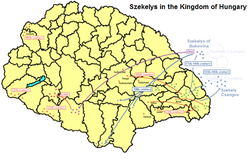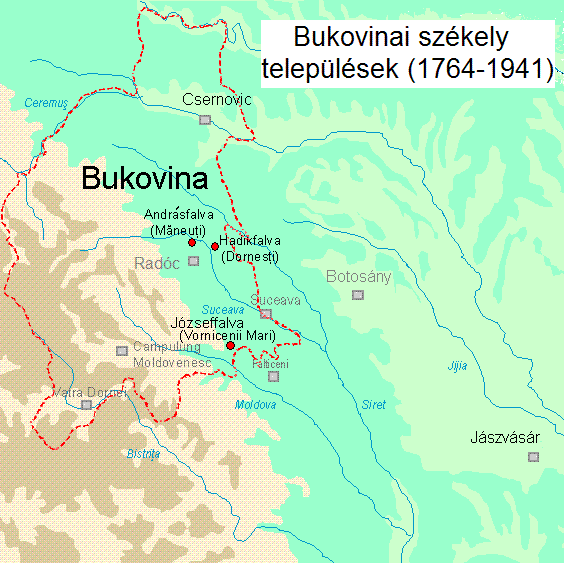
Székelys of Bukovina
Encyclopedia

Ethnic group
An ethnic group is a group of people whose members identify with each other, through a common heritage, often consisting of a common language, a common culture and/or an ideology that stresses common ancestry or endogamy...
with a complex history. They live today in the Tolna
Tolna
Tolna is a town in Tolna county, Hungary. It lies about north of Szekszárd and south of Budapest....
and Baranya
Baranya (county)
Baranya is the name of an administrative county in present Hungary, in the Baranya region, and also in the former Kingdom of Hungary ....
counties of Hungary, in Hunedoara County
Hunedoara County
Hunedoara is a county of Romania, in Transylvania, with its capital city at Deva.-Demographics:In 2002, it had a population of 485,712 and the population density was 69/km².*Romanians - 92%*Hungarians - 5%*Romas - 2%*Germans under 1%....
in Romania
Romania
Romania is a country located at the crossroads of Central and Southeastern Europe, on the Lower Danube, within and outside the Carpathian arch, bordering on the Black Sea...
and in the Serbia
Serbia
Serbia , officially the Republic of Serbia , is a landlocked country located at the crossroads of Central and Southeast Europe, covering the southern part of the Carpathian basin and the central part of the Balkans...
n province of Vojvodina
Vojvodina
Vojvodina, officially called Autonomous Province of Vojvodina is an autonomous province of Serbia. Its capital and largest city is Novi Sad...
.
Origins
Some SzékelySzékely
The Székelys or Székely , sometimes also referred to as Szeklers , are a subgroup of the Hungarian people living mostly in the Székely Land, an ethno-cultural region in eastern Transylvania, Romania...
groups migrated from Transylvania to the province of Bukovina
Bukovina
Bukovina is a historical region on the northern slopes of the northeastern Carpathian Mountains and the adjoining plains.-Name:The name Bukovina came into official use in 1775 with the region's annexation from the Principality of Moldavia to the possessions of the Habsburg Monarchy, which became...
in the second half of the 18th century and established new villages, where they retained their distinctive culture and folk traditions into the 20th century. The migration was a reaction to the organization by the Habsburg Empire of the Székely Frontier Zone, which jeopardized certain of the Székelys' ancient privileges and rights. The Székelys protested specifically against the forced military conscription
Conscription
Conscription is the compulsory enlistment of people in some sort of national service, most often military service. Conscription dates back to antiquity and continues in some countries to the present day under various names...
at a gathering at Madéfalva
Siculeni
Siculeni is a commune in Harghita County, Romania. It lies in the Székely Land, an ethno-cultural region in eastern Transylvania. It is composed of a single village, Siculeni. The Siculicidium took place here.-Demographics:...
, which was forcibly dispersed by the Austrian General Josef Siskovics in 7 January 1764, in what came to be known as the Siculicidium
Siculicidium
The Massacre at Madéfalva was a mass murder committed against Székelys by the Habsburg army in 1764, under Maria Theresa.-History:...
or Massacre of the Székelys. More than 400 Székelys died. Thereafter about 1000 Székelys migrated to Bukovina, then part of Moldavia
Moldavia
Moldavia is a geographic and historical region and former principality in Eastern Europe, corresponding to the territory between the Eastern Carpathians and the Dniester river...
and still under the suzerainty
Suzerainty
Suzerainty occurs where a region or people is a tributary to a more powerful entity which controls its foreign affairs while allowing the tributary vassal state some limited domestic autonomy. The dominant entity in the suzerainty relationship, or the more powerful entity itself, is called a...
of the Ottoman Empire
Ottoman Empire
The Ottoman EmpireIt was usually referred to as the "Ottoman Empire", the "Turkish Empire", the "Ottoman Caliphate" or more commonly "Turkey" by its contemporaries...
.

Iacobesti
Iacobeşti may refer to:* Iacobeşti, a village in Roşia Montană commune, Alba County, Romania* Iacobeşti, a village in Grăniceşti commune, Suceava County, Romania...
), Józseffalva (now Vornicenii Mari), Hadikfalva (now Dorneşti
Dornesti
Dorneşti is a commune located in Suceava County, Romania. It is composed of two villages, Dorneşti and Iaz....
) and Andrásfalva (now Măneuţi).
Overpopulation
The population of the Bukovina Székelys tripled in the 19th century, reaching 9887 in 1880 and about 16000 by the end of the 1930s. This caused an acute shortage of farmland and a sharp fall in standards of livingStandard of living
Standard of living is generally measured by standards such as real income per person and poverty rate. Other measures such as access and quality of health care, income growth inequality and educational standards are also used. Examples are access to certain goods , or measures of health such as...
. Many Bukovina Székelys left the villages temporarily or permanently, some with official assistance. The Hungarian government settled 4000 of these impoverished Székelys along the Lower Danube in the new villages of Hertelendyfalva
Vojlovica, Pancevo
Vojlovica is a former village that is part of the city of Pančevo, Serbia. Vojlovica’s centre is located 3,32 kilometers away from the Pančevo's centre. The geographical latitude of the settlement is North 44° 45' 42.9", while the longitude is East 20° 54' 20.72"...
, Sándoregyháza
Ivanovo (Serbia)
Ivanovo is a village located in the Pančevo municipality, in the South Banat District of Serbia.It is situated in the Autonomous Province of Vojvodina.- Geography :...
and Székelykeve
Skorenovac
Skorenovac is a village located in the Kovin municipality, in the South Banat District of Serbia, in the Autonomous Province of Vojvodina.-Geography:The closest towns are Kovin , Smederevo , Pančevo , and Belgrade...
in 1883, in a part of the Banat
Banat
The Banat is a geographical and historical region in Central Europe currently divided between three countries: the eastern part lies in western Romania , the western part in northeastern Serbia , and a small...
that was annexed by Yugoslavia
Yugoslavia
Yugoslavia refers to three political entities that existed successively on the western part of the Balkans during most of the 20th century....
in 1918 and today belongs to Serbia
Serbia
Serbia , officially the Republic of Serbia , is a landlocked country located at the crossroads of Central and Southeast Europe, covering the southern part of the Carpathian basin and the central part of the Balkans...
. Other Székely families emigrated in that period to Canada
Canada
Canada is a North American country consisting of ten provinces and three territories. Located in the northern part of the continent, it extends from the Atlantic Ocean in the east to the Pacific Ocean in the west, and northward into the Arctic Ocean...
, USA, Brazil
Brazil
Brazil , officially the Federative Republic of Brazil , is the largest country in South America. It is the world's fifth largest country, both by geographical area and by population with over 192 million people...
or cities in southern Transylvania.
Resettlements
Bukovina became part of RomaniaRomania
Romania is a country located at the crossroads of Central and Southeastern Europe, on the Lower Danube, within and outside the Carpathian arch, bordering on the Black Sea...
under the 1920 Treaty of Trianon
Trianon
Trianon may refer to:* Le Grand Trianon, a palace near Versailles, France* Le Petit Trianon, a château near Versailles, France* Le Trianon , a theatre and concert hall at 80, boulevard de Rochechouart in Paris...
, and the impoverished Székelys soon found themselves oppressed culturally as well as economically, with no teaching in or of Hungarian in their schools. There was a general expectation of assistance from the "mother country" and increasing urgency after the Second Vienna Award
Vienna Awards
The Vienna Awards are two arbitral awards by which arbiters of Nazi Germany and Fascist Italy sought to enforce peacefully the claims of Hungary on territory it had lost in 1920 when it signed the Treaty of Trianon...
of 1940 had caused widespread anti-Hungarian feeling in Bukovina. Hungary's 1941 invasion of Bačka
Backa
Bačka is a geographical area within the Pannonian plain bordered by the river Danube to the west and south, and by the river Tisza to the east of which confluence is located near Titel...
(Bácska) in northwestern Vojvodina
Vojvodina
Vojvodina, officially called Autonomous Province of Vojvodina is an autonomous province of Serbia. Its capital and largest city is Novi Sad...
was followed quickly by the expulsion of postwar Serbian settlers and other measures of forced Magyarization
Magyarization
Magyarization is a kind of assimilation or acculturation, a process by which non-Magyar elements came to adopt Magyar culture and language due to social pressure .Defiance or appeals to the Nationalities Law, met...
, of which resettlement of the Bukovina Székelys there was one. The whole community of 13,200 people left Romania under a treaty
Treaty
A treaty is an express agreement under international law entered into by actors in international law, namely sovereign states and international organizations. A treaty may also be known as an agreement, protocol, covenant, convention or exchange of letters, among other terms...
concluded between Hungary and Romania, by which the Bukovina Székelys lost their Romanian citizenship and almost all their possessions, receiving the confiscated possessions of displaced Serbs in Bačka and some charitable assistance in exchange. They were not resettled in their original village communities as they had expected, but spread about in small groups among 14 villages and hamlets. (Those from Andrásfalva, for example, belonged to the Reformed Church
Reformed Church in Hungary
The Reformed Church in Hungary is a key representative of Christianity in Hungary, being numerically the second-largest denomination in Hungary after the Roman Catholic Church, and the biggest denomination among ethnic Hungarians in Romania...
, while the others were Roman Catholics.)
The resettlement was short-lived. The tide of war turned and Hungary hurriedly evacuated Bačka on 8 October 1944. Most of the Bukovina Székelys managed to flee to Transdanubia
Transdanubia
Transdanubia is a traditional region of Hungary.-Traditional interpretation:The borders of Transdanubia are the Danube river , the Drava and Mura rivers and the foothills of the Alps roughly along the border between Hungary and Austria .Transdanubia comprises the counties of Győr-Moson-Sopron,...
before the vengeful Yugoslav partisan forces arrived, but again, they lost all of their property. Most were resettled in 1945-46 in the homes of expelled German in villages in the Völgység district of Tolna and adjacent counties. Tensions between them and the residual German population have eased over the decades. The Székelys of Tolna remain proud of their history and folk customs.
Sources
- Andrásfalvy Bertalan: A bukovinai székelyek kultúrájáról (The culture of the Bukovina Székelys). In: Népi kultúra népi társadalom (Folk culture, folk society). A MTA Néprajzi Kutató Csoportjának yearbook, ed. Gyula Ortutay (Budapest: Akadémiai Kiadó, 1973), pp. 7-23.
- Enikő A. Sajti: Hungarians in the Voivodina 1918-1947 (Boulder, CO/Highland Lakes, NJ: Social Science Monographs/Atlantic Research and Publications, 2003), pp. 250-297 passim.
- Sebestyén Ádám: A bukovinai andrásfalvi székelyek élete és története Madéfalvától napjainkig (Life and history of the Bukovina Székelys of Andrásfalva from Madéfalva to the present day) (Szekszárd: Tolna Megyei Tanács VB. Művelődésügyi Osztálya, 1972).
- Sebestyén Ádám: A bukovinai székelység tegnap és ma (The Bukovina Székelys past and present). Szekszárd: Tolna Megyei Könyvtár, 1989.
There is an extensive Hungarian bibliography on the discussion page.
See also
- SzékelySzékelyThe Székelys or Székely , sometimes also referred to as Szeklers , are a subgroup of the Hungarian people living mostly in the Székely Land, an ethno-cultural region in eastern Transylvania, Romania...
- BukovinaBukovinaBukovina is a historical region on the northern slopes of the northeastern Carpathian Mountains and the adjoining plains.-Name:The name Bukovina came into official use in 1775 with the region's annexation from the Principality of Moldavia to the possessions of the Habsburg Monarchy, which became...
- Székelykeve

